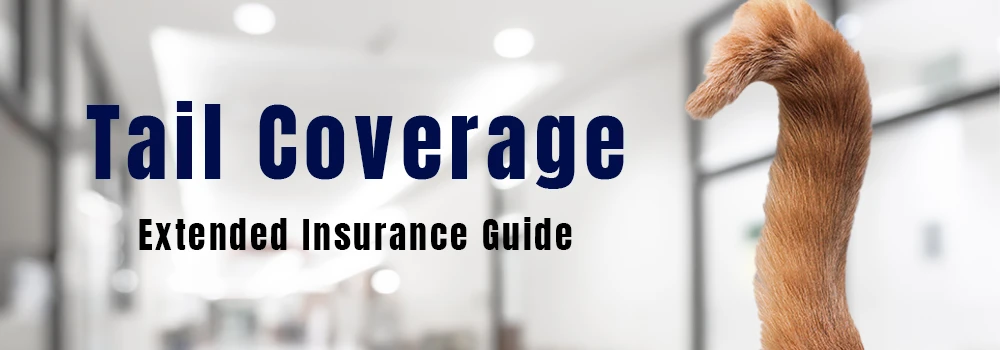
Tail coverage, or extended reporting period insurance, is a pivotal add-on to certain business insurance policies, providing an extended timeframe to file claims even after the lapse of the original insurance. Predominantly associated with claims-made policies like professional liability insurance, tail coverage acts as a safety net during transitions or breaks in your coverage. Let’s explore its mechanisms, acquisition, costs, and necessity.
Understanding Tail Coverage
Tail coverage, commonly referred to as tail insurance or an extended reporting period (ERP), is an indispensable adjunct to certain business insurance policies, primarily those structured on a claims-made basis. But what exactly is tail coverage, and why does it hold such significant relevance in the realm of business insurance?
Conceptual Clarity
At its core, tail coverage is about continuity and extended protection. It ensures that businesses and professionals remain shielded against liability claims that materialize after the termination of their insurance policies but originate from incidents within the policy duration. It doesn’t modify the original policy’s terms or limits; instead, it elongates the timeframe within which claims can be reported and processed.

Tail coverage adds an extra layer to your insurance when your coverage period runs out.
Benefits and Advantages
The quintessence of tail coverage lies in its ability to mitigate risks and uncertainties in dynamic business landscapes. For professionals and entities engaged in sectors prone to delayed claims or long-tail liabilities—such as healthcare, law, and consultancy—having tail coverage acts as a bulwark against unforeseen vulnerabilities, safeguarding financial integrity and professional reputation.
- Extended Reporting: It amplifies the temporal scope of insurance, ensuring that claims emerging post-policy expiration remain eligible for coverage, provided they stem from incidents within the policy period.
- Transition Safeguard: It is particularly salient during professional transitions such as retirement, business sale, or insurer switch, ensuring that coverage continuity is maintained during these phases.
- Risk Management: It enhances the resilience of businesses against the unpredictability of liability claims, fostering stability and confidence in operational pursuits.
Utilization Scenarios
Tail coverage manifests its utility across a spectrum of business scenarios and professional trajectories. It is a pivotal consideration for those engaged in professions subject to retrospective liabilities and claims, ensuring that the protective ambit of insurance remains uninterrupted despite policy cessation or transition. From legal professionals navigating the complexities of liability exposures to healthcare practitioners safeguarding against malpractice claims, tail coverage resonates as a strategic imperative in the architecture of comprehensive insurance portfolios.
Customization and Flexibility
Tail coverage offers a degree of customization, allowing policyholders to align their coverage extensions with strategic needs and risk assessments. Options range from annual to multi-year extensions, enabling businesses to calibrate their coverage durations based on risk perceptions, industry norms, and future plans.
Working Mechanism of Tail Coverage
The operational essence of tail coverage unfurls in its interaction with different types of insurance policies—primarily claims-made and occurrence-based policies. Understanding the nuanced workings of this coverage necessitates a deeper exploration of these interactions, elucidated through practical examples.
Claims-Made Policies: The Core Interaction
Tail coverage is inherently intertwined with claims-made policies. Here’s how it operates:
- Standard Operation: In a typical claims-made policy, both the harmful incident and the resulting claim must be lodged within the policy’s effective dates to be eligible for coverage.
- Tail Coverage Activation: It extends the framework, allowing claims to be filed even after the policy’s expiration, provided that the incident occurred during the policy’s lifespan.
Example: Consider a claims-made policy active from Jan 1, 2023, to Dec 31, 2023. Without tail coverage, a claim for an incident occurring on Dec 30, 2023, would need to be filed by Dec 31, 2023. With it, this claim could be filed later—say, in March 2024—and still be covered.
Occurrence-Based Policies: A Lesser Relevance
In occurrence-based policies, the emphasis lies on when the harmful act took place, not when the claim was filed. Tail coverage is less pertinent here because these policies naturally allow for claims to be filed after the policy ends, as long as the incident occurred during the coverage period.
Tail Coverage in Practice: Flexibility and Duration
It brings along flexibility, offering various durations for the extended reporting period—ranging from one year to unlimited extensions. This adaptability allows businesses and professionals to tailor the coverage based on anticipated risks and professional trajectories.
Example: A lawyer planning to retire might opt for a longer or even an unlimited tail duration, safeguarding against potential future liabilities stemming from past professional engagements.

Tail coverage allows you peace of mind knowing you’re still covered between insurance periods.
Acquiring Tail Coverage
Acquiring tail is a strategic decision, enveloped in a series of procedural and evaluative steps. This extension of your insurance portfolio is not merely a transaction but a calibrated choice influenced by various factors such as professional trajectory, industry risks, and insurer relationships.
Initiation: When to Consider?
The contemplation of tail coverage typically aligns with transitions—be it retirement, a switch in insurance providers, or any alteration in your professional status that might influence your liability exposures. Early consideration is paramount, ensuring that you are not left unprotected against emergent claims post-policy expiration.
Process and Procedure: How to Obtain?
Tail coverage is procured from your existing insurer as a supplemental addition to your claims-made policy. It is not a stand-alone product, and its acquisition is intricately tied to your ongoing insurance relations.
- Timing: Coverage is usually acquired at the conclusion of a claims-made policy or in anticipation of its termination.
- Insurer Engagement: Your existing insurer plays a pivotal role in facilitating coverage, necessitating a transparent and collaborative engagement to assess eligibility and terms.
Risk Assessment: Tailoring Your Coverage
Insurers undertake a comprehensive evaluation of risk factors, meticulously analyzing your work history, liability exposures, and the nature of professional engagements.
- Customization: Based on the risk assessment, your coverage is customized, ensuring alignment with your specific needs and risk profile.
- Strategic Planning: The acquisition of tail coverage should be strategically aligned with your broader risk management objectives and professional plans, ensuring optimized protection.
Exclusivity and Restrictions: Understanding the Limits
Tail coverage typically mandates an exclusive relationship with your current insurer. It is instrumental in understanding the inherent restrictions and ensuring that your decision is informed by a thorough appreciation of the terms and conditions.
Conclusion and Continuation: Securing Ongoing Protection
Securing coverage marks a significant step in fortifying your insurance architecture, ensuring that you are resilient against the evolving landscape of liabilities and claims. Its strategic acquisition is crucial, ensuring that your coverage is both comprehensive and attuned to your professional trajectory.
Cost Implications of Tail Coverage
The financial aspects of tail coverage are multifaceted, influenced by a tapestry of variables ranging from industry-specific risks to the nature of professional engagements and the strategic choices available to policyholders. Understanding the cost implications is essential for making informed and economically sound coverage decisions.
Industry Variability: Risk as a Cost Driver
Different industries come with divergent risk profiles, which significantly influence the cost of coverage. Sectors such as law and medicine, characterized by heightened liability exposures, often witness higher costs, reflecting the amplified risks associated with these professions.
Pricing Models: Calculating the Costs
The pricing of coverage can be quite flexible, yet it often leans towards the higher end of the spectrum. It is not uncommon for the costs to escalate up to three times the annual premium of the underlying claims-made policy, especially in high-risk industries.
Duration and Flexibility: Choosing Your Coverage Period
Tail coverage comes with a variety of duration options, each influencing the cost. Shorter extensions, such as one-year increments, might seem more financially palatable upfront, but longer durations offer sustained protection, albeit at higher costs.
- Annual Increments: Allows for a phased financial commitment, offering shorter periods of extended coverage.
- Multi-Year Options: Provides a more extended safety net, often advisable for professionals in high-risk sectors or those nearing retirement.
Strategic Considerations: Balancing Cost and Coverage
Strategizing the acquisition of tail coverage involves a careful balance between cost considerations and the extent of protection desired. A nuanced understanding of your risk profile, aligned with strategic objectives such as retirement planning or professional transitions, is crucial for making cost-effective decisions.
Get Tail Coverage Today
Armed with expertise, industry insights, and a commitment to personalized service, JMW Insurance Solutions stands ready to guide you through the intricacies of tail coverage. Our dedicated team will collaborate with you to craft a coverage strategy that is both robust and aligned with your professional objectives and industry risks.
Reach out to us at JMW Insurance Solutions, and embark on a journey towards securing a tail coverage plan that embodies protection, foresight, and strategic alignment with your professional trajectory.
